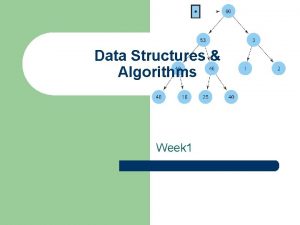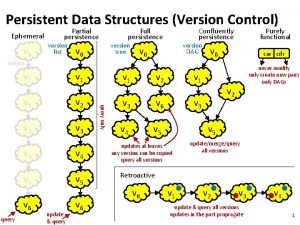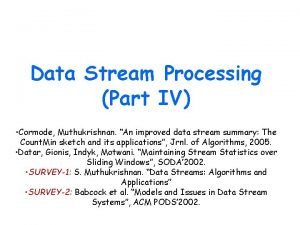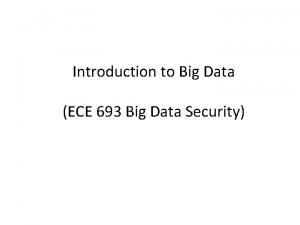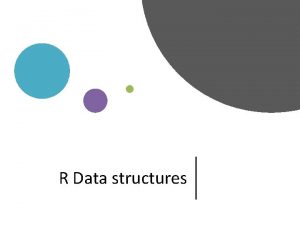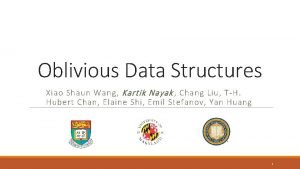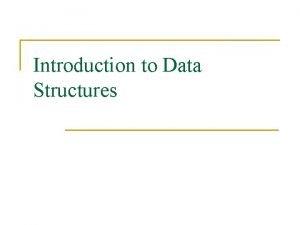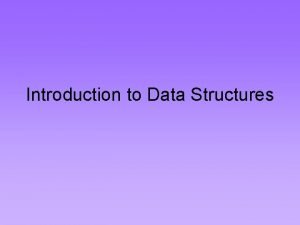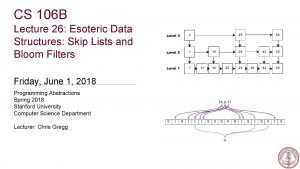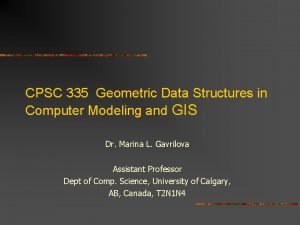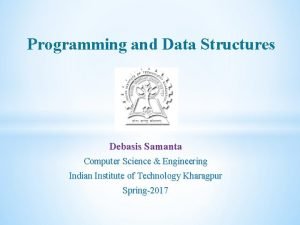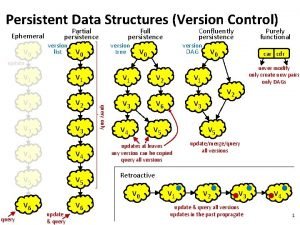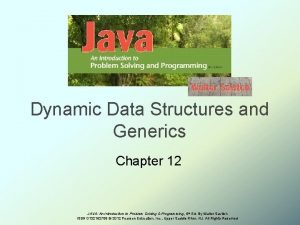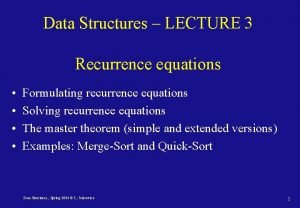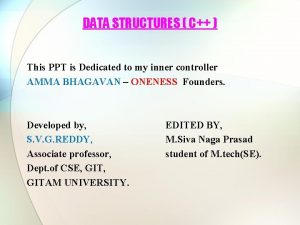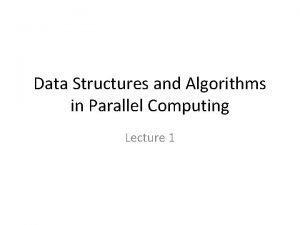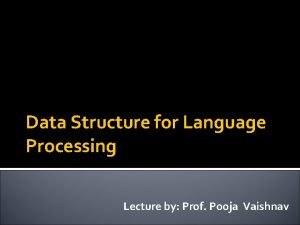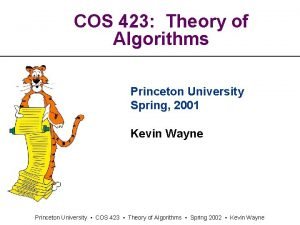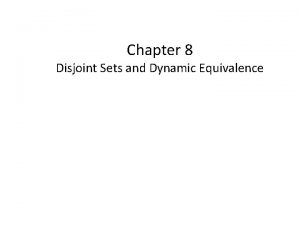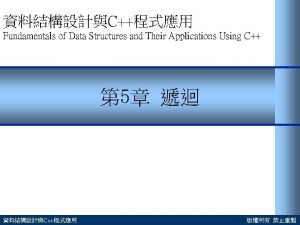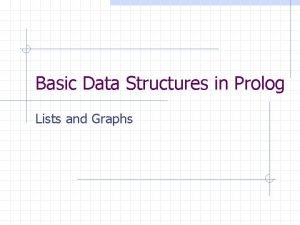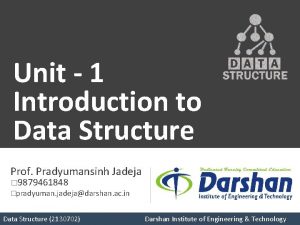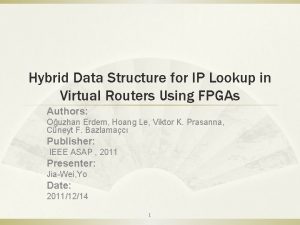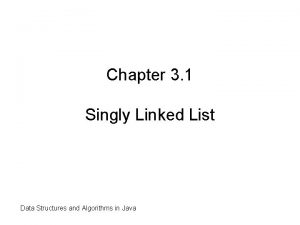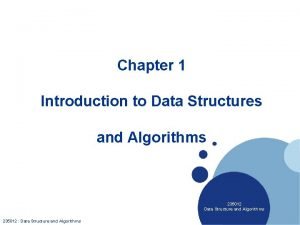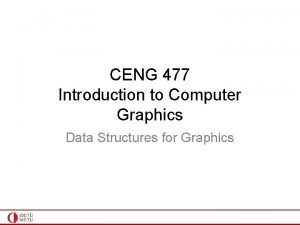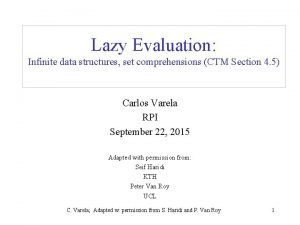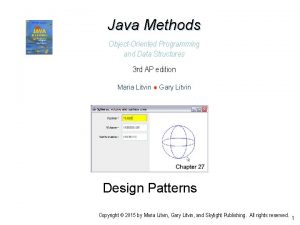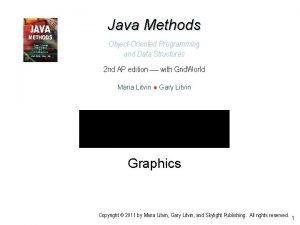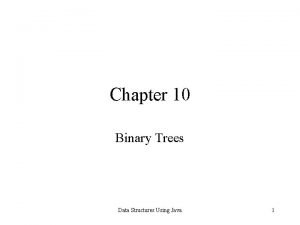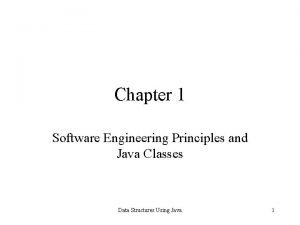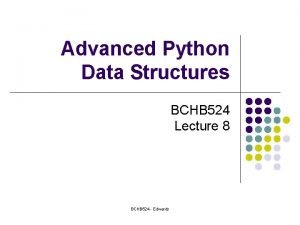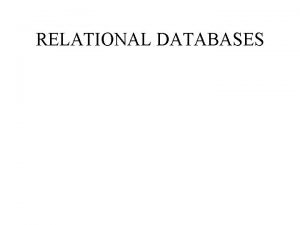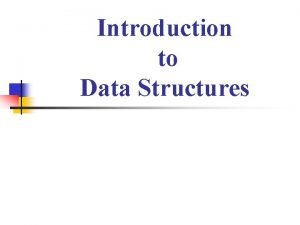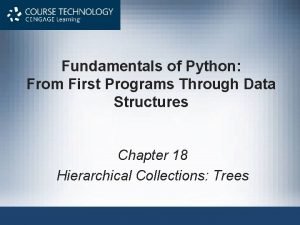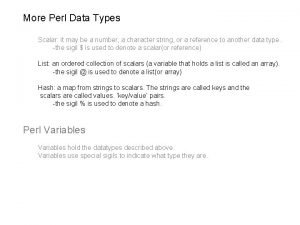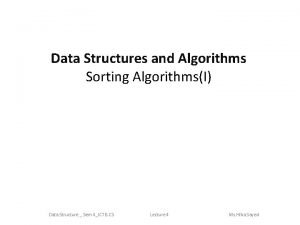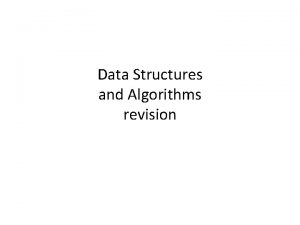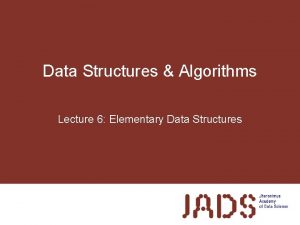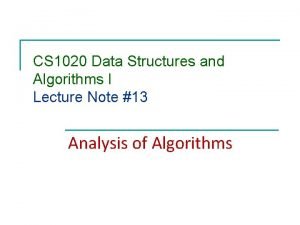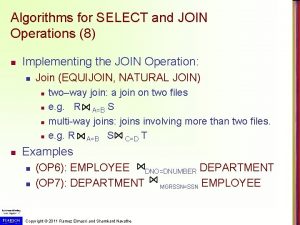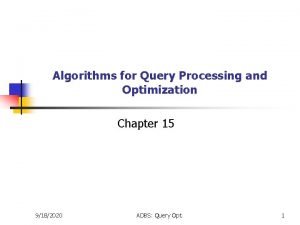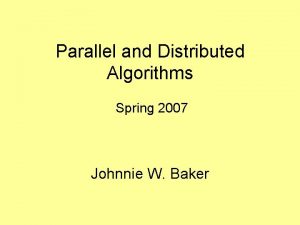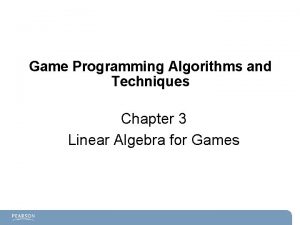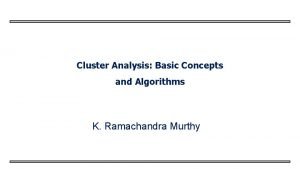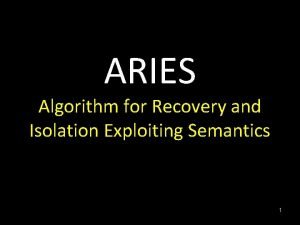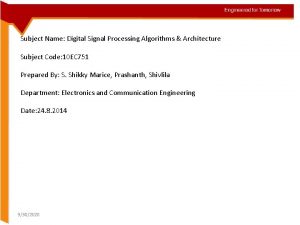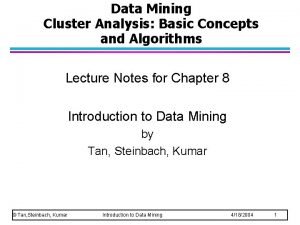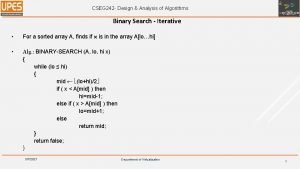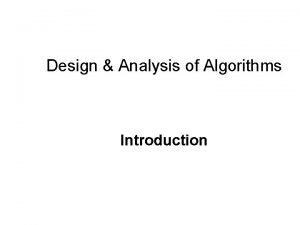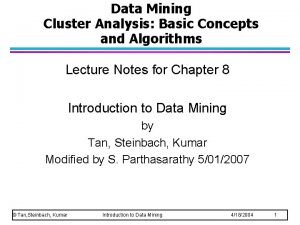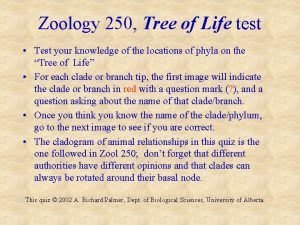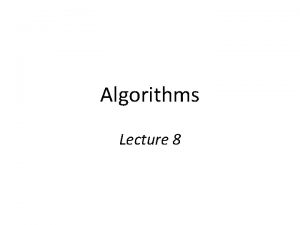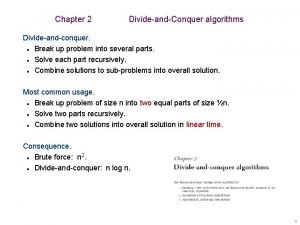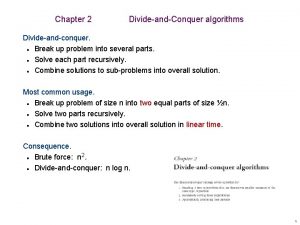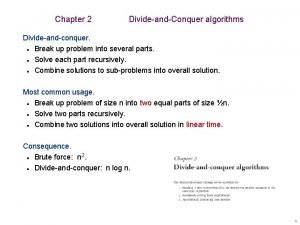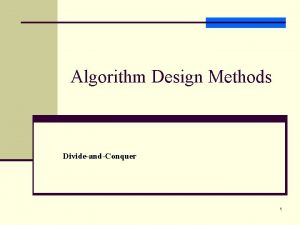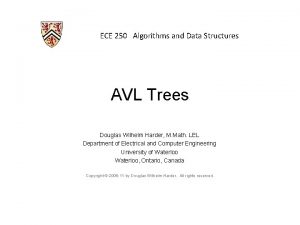ECE 250 Algorithms and Data Structures Divideandconquer algorithms
















































































































- Slides: 112

ECE 250 Algorithms and Data Structures Divide-and-conquer algorithms Douglas Wilhelm Harder, M. Math. LEL Department of Electrical and Computer Engineering University of Waterloo, Ontario, Canada ece. uwaterloo. ca dwharder@alumni. uwaterloo. ca © 2006 -2013 by Douglas Wilhelm Harder. Some rights reserved.

Divide-and-conquer algorithms 2 Divide-and-conquer algorithms We have seen four divide-and-conquer algorithms: – – Binary search Depth-first tree traversals Merge sort Quick sort The steps are: – A larger problem is broken up into smaller problems – The smaller problems are recursively – The results are combined together again into a solution

Divide-and-conquer algorithms 3 Divide-and-conquer algorithms For example, merge sort: – Divide a list of size n into b = 2 sub-lists of size n/2 entries – Each sub-list is sorted recursively – The two sorted lists are merged into a single sorted list

Divide-and-conquer algorithms 4 Divide-and-conquer algorithms More formally, we will consider only those algorithms which: – Divide a problem into b sub-problems, each approximately of size n/b • Up to now, b = 2 – Solve a ≥ 1 of those sub-problems recursively • Merge sort and tree traversals solved a = 2 of them • Binary search solves a = 1 of them – Combine the solutions to the sub-problems to get a solution to the overall problem

Divide-and-conquer algorithms 5 Divide-and-conquer algorithms With the three problems we have already looked at we have looked at two possible cases for b = 2: Merge sort Depth-first traversal Binary search b=2 b=2 a=2 a=1 Problem: the first two have different run times: Merge sort Depth-first traversal Q(n ln(n) ) Q(n)

Divide-and-conquer algorithms 6 Divide-and-conquer algorithms Thus, just using a divide-and-conquer algorithm does not solely determine the run time We must also consider – The effort required to divide the problem into two sub-problems – The effort required to combine the two solutions to the sub-problems

Divide-and-conquer algorithms 7 Divide-and-conquer algorithms For merge sort: – Division is quick (find the middle): Q(1) – Merging the two sorted lists into a single list is a Q(n) problem For a depth-first tree traversal: – Division is also quick: Q(1) – A return-from-function is preformed at the end which is Q(1) For quick sort (assuming division into two): – Dividing is slow: Q(n) – Once both sub-problems are sorted, we are finished: Q(1)

Divide-and-conquer algorithms 8 Divide-and-conquer algorithms Thus, we are able to write the expression as follows: – Binary search: Q(ln(n)) – Depth-first traversal: Q(n) – Merge/quick sort: Q(n ln(n)) In general, we will assume the work done combined work is of the form O(nk)

Divide-and-conquer algorithms 9 Divide-and-conquer algorithms Thus, for a general divide-and-conquer algorithm which: – Divides the problem into b sub-problems – Recursively solves a of those sub-problems – Requires O(nk) work at each step requires has a run time Note: we assume a problem of size n = 1 is solved. . .

Divide-and-conquer algorithms 10 Divide-and-conquer algorithms Before we solve the general case, let us look at some more complex examples: – Searching an ordered matrix – Integer multiplication (Karatsuba algorithm) – Matrix multiplication

Divide-and-conquer algorithms 11 Searching an ordered matrix Consider an n × n matrix where each row and column is linearly ordered; for example: – How can we determine if 19 is in the matrix?

Divide-and-conquer algorithms 12 Searching an ordered matrix Consider the following search for 19: – Search across until ai, j + 1 > 19 – Alternate between • Searching down until ai, j > 19 • Searching back until ai, j < 19 This requires us to check at most 3 n entries: O(n)

Divide-and-conquer algorithms 13 Searching an ordered matrix Can we do better than O(n)? Logically, no: any number could appear in up to n positions, each of which must be checked – Never-the-less: let’s generalize checking the middle entry

Divide-and-conquer algorithms 14 Searching an ordered matrix 17 < 19, and therefore, we can only exclude the top-left sub-matrix:

Divide-and-conquer algorithms 15 Searching an ordered matrix Thus, we must recursively search three of the four sub-matrices – Each sub-matrix is approximately n/2 × n/2

Divide-and-conquer algorithms 16 Searching an ordered matrix If the number we are searching for was less than the middle element, e. g. , 9, we would have to search three different squares

Divide-and-conquer algorithms 17 Searching an ordered matrix Thus, the recurrence relation must be because – – T(n) is the time to search a matrix of size n × n The matrix is divided into 4 sub-matrices of size n/2 × n/2 Search 3 of those sub-matrices At each step, we only need compare the middle element: Q(1)

Divide-and-conquer algorithms 18 Searching an ordered matrix We can solve the recurrence relationship using Maple: > rsolve( {T(n) = 3*T(n/2) + 1, T(1) = 1}, T(n) ); > evalf( log[2]( 3 ) );

Divide-and-conquer algorithms 19 Searching an ordered matrix Therefore, this search is approximately O(n 1. 585), which is significantly worse than a linear search:

Divide-and-conquer algorithms 20 Searching an ordered matrix Note that it is T(n) = 3 T(n/2) + Q(1) and not T(n) = 3 T(n/4) + Q(1) We are breaking the n × n matrix into four (n/2) × (n/2) matrices If N = n 2, then we could write T(N) = 3 T(N/4) + Q(1)

Divide-and-conquer algorithms 21 Searching an ordered matrix Where is such a search necessary? – Consider a bi-parental heap – Without proof, most operations are O( ) including searches – Binary heaps: most operations are O(ln(n)) but searches are O(n)

Divide-and-conquer algorithms 22 Searching an ordered matrix For example, consider a search for the value 44: – The matrix has n entries in See: http: //ece. uwaterloo. ca/~dwharder/aads/Algorithms/Beaps/

Divide-and-conquer algorithms 23 Searching an ordered matrix Note: the linear searching algorithm is only optimal for square matrices – A binary search would be optimal for a 1 × n or n × 1 matrix – Craig Gidney posts an interesting discussion on such searches when the matrix is not close to square http: //twistedoakstudios. com/blog/Post 5365_searching-a-sorted-matrix-faster

Divide-and-conquer algorithms 24 Integer multiplication Calculate the product of two 16 -digit integers 3563474256143563 × 8976558458718976 Multiplying two n-digit numbers requires Q(n 2) multiplications of two decimal digits: 3563474256143563 × 8976558458718976 21380845536861378 24944319793004941 32071268305292067 28507794049148504 3563474256143563 24944319793004941 28507794049148504 17817371280717815 14253897024574252 28507794049148504 17817371280717815 21380845536861378 24944319793004941 32071268305292067 + 28507794049148504. 31987734976412811376690928351488 n

Divide-and-conquer algorithms 25 Integer multiplication Rewrite the product 3563474256143563 × 8976558458718976 as (35634742 × 108 + 56143563) × (89765584× 108 + 58718976) which requires four multiplications of 8 -digit integers: (35634742 × 89765584)× 1016 + (35634742 × 58718976 + 56143563 × 89765584)× 108 + (56143563 × 58718976) Adding two n-digit integers is a Q(n) operation

Divide-and-conquer algorithms 26 Integer multiplication Thus, the recurrence relation is: Again, we solve the recurrence relation using Maple: > rsolve( {T(n) = 4*T(n/2) + n, T(1) = 1}, T(n) ); This is still Q(n 2)

Divide-and-conquer algorithms 27 Integer multiplication To reduce the run time, the Karatsuba algorithm (1961) reduces the number of multiplications Let x = 3563474256143563 y = 8976558458718976 and define x. MS = 35634742 x. LS = 56143563 y. MS = 89765584 y. LS = 58718976 and thus x = x. MS× 108 + x. LS y = y. MS× 108 + y. LS

Divide-and-conquer algorithms 28 Integer multiplication The multiplication is now: xy = x. MSy. MS× 1016 + (x. Ly. R + x. Ry. L)× 108 + x. LSy. LS Rewrite the middle product as x. MSy. LS + x. LSy. MS = (x. LS – x. MS)(y. LS – y. MS) + x. MSy. MS + x. LSy. LS Two of these are already calculated!

Divide-and-conquer algorithms 29 Integer multiplication Thus, the revised recurrence relation may again be solved using Maple: > rsolve( {T(n) = 3*T(n/2) + n, T(1) = 1}, T(n) ); where log 2(3) ≈ 1. 585

Divide-and-conquer algorithms 30 Integer multiplication Plotting the two functions n 2 and n 1. 585, we see that they are significantly different

Divide-and-conquer algorithms 31 Integer multiplication This is the same asymptotic behaviour we saw for our alternate searching behaviour of an ordered matrix, however, in this case, it is an improvement on the original run time! Even more interesting is that the recurrence relation are different: – T(n) = 3 T(n/2) + Q(n) integer multiplication – T(n) = 3 T(n/2) + Q(1) searching an ordered matrix

Divide-and-conquer algorithms 32 Integer multiplication In reality, you would probably not use this technique: there are others There also libraries available for fast integer multiplication For example, the GNU Image Manipulation Program (GIMP) comes with a complete set of tools for fast integer arithmetic http: //www. gimp. org/

Divide-and-conquer algorithms 33 Integer multiplication The Toom-Cook algorithm (1963 and 1966) splits the integers into k parts and reduces the k 2 multiplications to 2 k – 1 – Complexity is Q(nlogk(2 k – 1)) – Karatsuba is a special case when k = 2 – Toom-3 (k = 3) results in a run time of Q(nlog 3(5)) = Q(n 1. 465) The Schönhage-Strassen algorithm runs in Q(n ln(n) ln(ln(n))) time but is only useful for very large integers (greater than 10 000 decimal digits)

Divide-and-conquer algorithms 34 Matrix multiplication Consider multiplying two n × n matrices, C = AB This requires the Q(n) dot product of each of the n rows of A with each of the n columns of B j ci, j i The run time must be Q(n 3) – Can we do better?

Divide-and-conquer algorithms 35 Matrix multiplication In special cases, faster algorithms exist: – If both matrices are diagonal or tri-diagonal Q(n) – If one matrix is diagonal or tri-diagonal Q(n 2) In general, however, this was not believed to be possible to do better

Divide-and-conquer algorithms 36 Matrix multiplication Consider this product of two n × n matrices – How can we break this down into smaller sub-problems?

Divide-and-conquer algorithms 37 Matrix multiplication Break each matrix into four (n/2) × (n/2) sub-matrices – Write each sub-matrix of C as a sum-of-products A B C

Divide-and-conquer algorithms 38 Matrix multiplication Justification: cij is the dot product of the ith row of A and the jth column of B ci, j

Divide-and-conquer algorithms 39 Matrix multiplication This is equivalent for each of the sub-matrices:

Divide-and-conquer algorithms 40 Matrix multiplication We must calculate the four sums-of-products C 00 = A 00 B 00 + A 01 B 10 C 01 = A 00 B 01 + A 01 B 11 C 10 = A 10 B 00 + A 11 B 10 C 11 = A 10 B 01 + A 11 B 11 This totals 8 products of (n/2) × (n/2) matrices – This requires four matrix-matrix additions: Q(n 2)

Divide-and-conquer algorithms 41 Matrix multiplication The recurrence relation is: Using Maple: > rsolve( {T(n) = 8*T(n/2) + n^2, T(1) = 1}, T(n) );

Divide-and-conquer algorithms 42 Matrix multiplication In 1969, Strassen developed a technique for performing matrix multiplication in Q(nlg(7)) ≈ Q(n 2. 807) time – Reduce the number of matrix-matrix products

Divide-and-conquer algorithms 43 Matrix multiplication Consider the following seven matrix products M 1 = (A 00 – A 10)(B 00 + B 01) M 2 = (A 00 + A 11)(B 00 + B 11) M 3 = (A 01 – A 11)(B 10 + B 11) M 4 = A 00(B 01 – B 11) M 5 = A 11(B 10 – B 00) The four sub-matrices of C may be written as M 6 = (A 10 + A 11)B 00 M 7 = (A 00 + A 01)B 11 C 00 = M 3 + M 2 + M 5 – M 7 C 01 = M 4 + M 7 C 10 = M 5 + M 6 C 11 = M 2 – M 1 + M 4 – M 6

Divide-and-conquer algorithms 44 Matrix multiplication Thus, the new recurrence relation is: Using Maple: > rsolve( {T(n) = 7*T(n/2) + n^2, T(1) = 1}, T(n) );

Divide-and-conquer algorithms 45 Matrix multiplication Note, however, that there is a lot of additional work required Counting additions and multiplications: Classic 2 n 3 – n 2 Strassen 7 nlg(7) – 6 n 2

Divide-and-conquer algorithms 46 Matrix multiplication Examining this plot, and then solving explicitly, we find that Strassen’s method only reduces the number of operations for n > 654 – Better asymptotic behaviour does not immediately translate into better run-times The Strassen algorithm is not the fastest – the Coppersmith–Winograd algorithm runs in Q(n 2. 376) time but the coefficients are too large for any problem Therefore, better asymptotic behaviour does not immediately translate into better run-times

Divide-and-conquer algorithms 47 Observation Some literature lists the run-time as O(7 lg(n)) Recall that these are equal: 7 lg(n) = nlg(7) Proof: 7 lg(n) = (2 lg(7)) lg(n) = 2 lg(7) lg(n) = 2 lg(n) lg(7) = (2 lg(n)) lg(7) = n lg(7)

Divide-and-conquer algorithms 48 Fast Fourier transform The last example is the fast Fourier transform – This takes a vector from the time domain to the frequency domain The Fourier transform is a linear transform – For finite dimensional vectors, it is a matrix-vector product Fnx http: //xkcd. com/26/

Divide-and-conquer algorithms 49 Fast Fourier transform To perform a linear transformation, it is necessary to calculate a matrix-vector product:

Divide-and-conquer algorithms 50 Fast Fourier transform We can apply a divide and conquer algorithm to this problem – Break the matrix-vector product into four matrix-vector products, each of half the size

Divide-and-conquer algorithms 51 Fast Fourier transform The recurrence relation is: Using Maple: > rsolve( {T(n) = 4*T(n/2) + n, T(1) = 1}, T(n) ); n (2 n – 1)

Divide-and-conquer algorithms 52 Discrete Fourier transform To introduce the Fourier transform, we need a little information about complex numbers: – There are two complex numbers z such that z 2 = 1

Divide-and-conquer algorithms 53 Discrete Fourier transform To introduce the Fourier transform, we need a little information about complex numbers: – There are three complex numbers z such that z 3 = 1

Divide-and-conquer algorithms 54 Discrete Fourier transform To introduce the Fourier transform, we need a little information about complex numbers: – There are four complex numbers z such that z 4 = 1

Divide-and-conquer algorithms 55 Discrete Fourier transform To introduce the Fourier transform, we need a little information about complex numbers: – There are five complex numbers z such that z 5 = 1

Divide-and-conquer algorithms 56 Discrete Fourier transform To introduce the Fourier transform, we need a little information about complex numbers: – There are eight complex numbers z such that z 8 = 1 – These are also known as the eighth roots of unity – That root with the smallest non-zero angle is said to be the eighth principle root of unity

Divide-and-conquer algorithms 57 Discrete Fourier transform In n dimensions, the Fourier transform matrix is where w = e– 2 pj/n is the conjugate nth principal root of unity

Divide-and-conquer algorithms 58 Discrete Fourier transform For example, the matrix for the Fourier transform for 4 -dimensions is Here, w = –j is the conjugate 4 th principal root of unity Note that: – The matrix is symmetric – All the column/row vectors are orthogonal – These create a orthogonal basis for C 4

Divide-and-conquer algorithms 59 Discrete Fourier transform Any matrix-vector multiplication is usually Q(n 2) – The discrete Fourier transform is a useful tool in all fields of engineering – In general, it is not possible to speed up a matrix-vector multiplication – In this case, however, the matrix has a peculiar shape • That of a very special Vandermonde matrix

Divide-and-conquer algorithms 60 Fast Fourier transform We will now look at the Cooley–Tukey algorithm for calculating the discrete Fourier transform – This fast transform can only be applied the dimension is a power of two – We will look at the 8 -dimensional transform matrix – The eighth conjugate root of unity is – Note that w 2 = –j, w 4 = – 1 and w 8 = 1

Divide-and-conquer algorithms 61 Fast Fourier transform This is the 8 × 8 Fourier transform matrix – We will write w 0 instead of 1 so that we can see the pattern – We will number the columns 0, 1, 2, …, 7

Divide-and-conquer algorithms 62 Fast Fourier transform Now by definition, w 8 = 1, so we can make some simplifications – For example, w 14 = w 8 + 6 = w 8 w 6 = w 6 – We may use, wn = wn mod 8 – For example, w 49 = w 49 mod 8 = w 1

Divide-and-conquer algorithms 63 Fast Fourier transform Now we’ve simplified the matrix with powers on the range 0 to 7

Divide-and-conquer algorithms 64 Fast Fourier transform As 8 is even, w 4 = – 1 – Thus, we replace w 4 = – w 0 w 5 = – w 1 w 6 = – w 2 w 7 = – w 3

Divide-and-conquer algorithms 65 Fast Fourier transform Now we may observe some patterns

Divide-and-conquer algorithms 66 Fast Fourier transform Note that the even columns (0, 2, 4, 6) are powers of w 2 – Note also that rth If w on c h t igh e e h is t oot r e t juga o 2 w , y f unit fou e h t is nity u f o oot r e t ga u j n o c

Divide-and-conquer algorithms 67 Fast Fourier transform The shape of the odd columns (1, 3, 5, 7) is less obvious

Divide-and-conquer algorithms 68 Fast Fourier transform Let’s rearrange the columns of the matrix and the entries of the vector 0 2 4 1 6 3 5 7

Divide-and-conquer algorithms 69 Fast Fourier transform Recall that w is the 8 th conjugate root of unity – Therefore, w 2 is the 4 th conjugate root of unity – Both these matrices are the Fourier transform for a 4 -dimensional vector

Divide-and-conquer algorithms 70 Fast Fourier transform We will label these two blocks as F 4 F 4

Divide-and-conquer algorithms 71 Fast Fourier transform There is one obvious pattern in the second pair of matrices – The bottom matrix is the negative of the top – The other pattern is more subtle F 4

Divide-and-conquer algorithms 72 Fast Fourier transform The top matrix is a diagonal multiplied by F 4 F 4

Divide-and-conquer algorithms 73 Fast Fourier transform Represent that diagonal matrix by – Recall that multiplying a vector by a diagonal matrix is Q(n) F 4 D 4 F 4

Divide-and-conquer algorithms 74 Fast Fourier transform From our previous observation, the bottom matrix is –D 4 F 4 F 4 –D 4 F 4

Divide-and-conquer algorithms 75 Fast Fourier transform Thus, our adjusted Fourier transform matrix is a block matrix consisting of four 4 × 4 matrices F 4 D 4 F 4 –D 4 F 4

Divide-and-conquer algorithms 76 Fast Fourier transform Let’s split up the vector into two vectors F 4 D 4 F 4 –D 4 F 4

Divide-and-conquer algorithms 77 Fast Fourier transform 4 × 4 matrices Thus, we have the relation: 4 -dimensional vectors Thus, Note that we want to calculate and not – The first is Q(n + TF(n)), the second Q(n 2 + TF(n)) – That is, calculate the FFT of (a vector) and then multiply the entries of that vector by the diagonal entries

Divide-and-conquer algorithms 78 Fast Fourier transform Now we must calculate and – Calculating and – Adding and – Rearranging the results is also Q(n) recursively are both Q(n) operations are also both Q(n)

Divide-and-conquer algorithms 79 Fast Fourier transform Thus, we have that the time T(n) requires that we – Divide the vector v into the vectors and – Calculate – Add and recursively and – Reorder the results to get the result F 8 v The recurrence relation now – This is the run-time of merge sort: Q(n ln(n)) Q(n) 2 T(n/2) Q(n)

Divide-and-conquer algorithms 80 Fast Fourier transform An argument that this generalizes for other powers of two: – The even columns of are powers of w 2 w 0 w 2 w 4 w 6 w 8 ··· w 0 w 4 w 8 w 12 w 16 ··· – The normalized bottom halves equal the top halves – The odd columns are of the form w 0 w 3 w 6 w 9 w 12 ··· w 0 w 5 w 10 w 15 w 20 ··· – These can be written as w 0·w 0 w 1·w 2 w 2·w 4 w 3· w 6 w 4· w 8 ··· w 0·w 0 w 1·w 4 w 2·w 8 w 3·w 12 w 4·w 16 ··· – The normalized bottom halves are the top halves multiplied by

Divide-and-conquer algorithms 81 Fast Fourier transform void FFT( std: : complex<double> *array, int n ) { if ( n == 1 ) return; std: : complex<double> even[n/2]; std: : complex<double> odd[n/2]; for ( int k = 0; k < n/2; ++k ) { even[k] = array[2*k]; odd[k] = array[2*k + 1]; } FFT( even, n/2 ); FFT( odd, n/2 ); double const PI = 4. 0*std: : atan( 1. 0 ); std: : complex<double> w = 1. 0; std: : complex<double> wn = std: : exp( std: : complex<double>( 0. 0, -2. 0*PI/n ) ); for ( int k = 0; k < n/2; ++k ) { array[k] = even[k] + w*odd[k]; array[n/2 + k] = even[k] - w*odd[k]; w = w * wn; } }

Divide-and-conquer algorithms 82 Divide and Conquer We have now looked at a number of divide-and-conquer algorithms, and come up with a number of different run times: Binary search Tree traversals Merge sort Ordered-matrix search Integer multiplication Toom-3 integer multiplication Q(nlog 3(5)) Matrix multiplication Fast Fourier transform T(n) = T(n/2) + Q(1) O(ln(n)) T(n) = 2 T(n/2) + Q(1) Q(n) T(n) = 2 T(n/2) + Q(n) Q(n ln(n)) T(n) = 3 T(n/2) + Q(1) O(nlg(3)) T(n) = 3 T(n/2) + Q(n) Q(nlg(3)) T(n) = 5 T(n/3) + Q(n) T(n) = 7 T(n/2) + Q(n 2) Q(nlg(7)) T(n) = 2 T(n/2) + Q(n) Q(n ln(n))

Divide-and-conquer algorithms 83 The master theorem We used Maple to solve the recurrence relationships We will now solve the general problem

Divide-and-conquer algorithms 84 The master theorem In all cases when b = 2, we assumed n = 2 m That is, n = 1, 2, 4, 8, 16, 32, 64, . . and interpolated the intermediate results

Divide-and-conquer algorithms 85 The master theorem In this case, we will assume n = bm, as we are dividing each interval into b equal parts n = 1, b, b 2, b 3, . . . As before, we will interpolate intermediate behaviour – Thus, we will solve T(bm) and use this to approximate T(n)

Divide-and-conquer algorithms 86 The master theorem Thus, given the recurrence relation we have that We can rewrite this as: bk is a constant

Divide-and-conquer algorithms 87 The master theorem Therefore, we may iterate:

Divide-and-conquer algorithms 88 The master theorem Determining a pattern is possible, however, we can determine the pattern more easily if we divide both sides by am: We can simplify this to:

Divide-and-conquer algorithms 89 The master theorem We can repeatedly calculate this formula for smaller and smaller values of m:

Divide-and-conquer algorithms 90 The master theorem Thus, we may carry on

Divide-and-conquer algorithms 91 The master theorem A telescoping series is any series of the form Alternatively, if More generally, we have: , it follows that

Divide-and-conquer algorithms 92 The master theorem Thus, we find: +

Divide-and-conquer algorithms 93 The master theorem We can sum these: and simplify:

Divide-and-conquer algorithms 94 The master theorem We multiply by am to get

Divide-and-conquer algorithms 95 The master theorem The sum is a geometric series, and the actual value will depend on the ratio Recall that for a geometric series, if r < 1 then the series converges:

Divide-and-conquer algorithms 96 The master theorem Also, if r = 1, we have: If r > 1, we can only determine a finite sum:

Divide-and-conquer algorithms 97 The master theorem Thus, we consider three possible cases

Divide-and-conquer algorithms 98 The master theorem These may be roughly translated into: – The number of recursions at each step is more significant than the amount of work at each step (bk < a) – The contributions are equal (bk = a) – The amount of work at each step is more significant than the additional work contributed by the recursion (bk > a)

Divide-and-conquer algorithms 99 bk < a Which examples fall in this case? a b k bk Traversal 2 2 0 1 Quaternary search of an ordered matrix 3 2 0 1 Karatsuba’s integer-multiplication algorithm 3 2 1 2 Toom-3 integer-multiplication algorithm 5 3 1 3 Strassen’s matrix-multiplication algorithm 7 2 2 4

Divide-and-conquer algorithms 100 bk < a In this case, where is a constant which we may asymptotically ignore

Divide-and-conquer algorithms 101 bk < a Therefore, T(n) = O(am) By assumption, n = bm, hence m =logbn and therefore T(n) = O(alogbn) = O(nlogba)

Divide-and-conquer algorithms 102 bk < a Going back to our examples: a b k bk logb(a) Run time Traversal 2 2 0 1 1. 000 O(n) Quaternary search of an ordered matrix 3 2 0 1 1. 585 O(n 1. 585) Karatsuba’s integer-multiplication algorithm 3 2 1. 465 O(n 1. 585) Toom-3 integer-multiplication algorithm 5 3 1. 465 O(n 1. 465) Strassen’s matrix-multiplication algorithm 7 2 2 4 2. 807 O(n 2. 807)

Divide-and-conquer algorithms 103 bk = a Which examples fall in this case? a b k bk Binary search 1 2 0 1 Merge sort 2 2 1 2 Fast Fourier transform 2 2 1 2

Divide-and-conquer algorithms 104 bk = a In this case, Therefore, T(n) = O(mam) By assumption, n = bm and a = bk ∴ m = logbn and k = logba Hence

Divide-and-conquer algorithms 105 bk = a Going back to our examples: a b k bk Run time Binary search 1 2 0 1 O(1·ln(n)) Merge sort 2 2 1 1 O(n ln(n)) Fast Fourier transform 2 2 1 2 O(n ln(n))

Divide-and-conquer algorithms 106 bk > a We haven’t seen any examples that fall into this case – Suppose we divide the problem into two, but we must perform a linear operation to determine which half to recursively call Sample a b k bk 1 2

Divide-and-conquer algorithms 107 bk > a In this case, Factor out the constant term and simplify to get: Both positive constants (see assumption)

Divide-and-conquer algorithms 108 bk > a Recall that if p < q then pm = o(qm), hence am = o((bk)m) Thus, we can ignore the second term: T(n) = O(bkm – am) = O(bkm) Again, by assumption, n = bm, hence T(n) = O((bm)k) = O(nk)

Divide-and-conquer algorithms 109 bk > a Going back to our example: Sample a b k bk Run time 1 2 O(n 1) The linear operation contributes more than the divide-and-conquer component

Divide-and-conquer algorithms 110 Summary of cases To summarize these run times:

Divide-and-conquer algorithms 111 Summary Therefore: – If the amount of work being done at each step to either sub-divide the problem or to recombine the solutions dominates, then this is the run time of the algorithm: O(nk) – If the problem is being divided into many small sub-problems (a > bk) then the number of sub-problems dominates: O(nlogb(a)) – In between, a little more (logarithmically more) work must be done

Divide-and-conquer algorithms 112 References Wikipedia, http: //en. wikipedia. org/wiki/Divide_and_conquer These slides are provided for the ECE 250 Algorithms and Data Structures course. The material in it reflects Douglas W. Harder’s best judgment in light of the information available to him at the time of preparation. Any reliance on these course slides by any party for any other purpose are the responsibility of such parties. Douglas W. Harder accepts no responsibility for damages, if any, suffered by any party as a result of decisions made or actions based on these course slides for any other purpose than that for which it was intended.
 Professor ajit diwan
Professor ajit diwan Amit agarwal princeton
Amit agarwal princeton Data structures and algorithms tutorial
Data structures and algorithms tutorial Information retrieval data structures and algorithms
Information retrieval data structures and algorithms Data structures and algorithms bits pilani
Data structures and algorithms bits pilani Ajit diwan iitb
Ajit diwan iitb Data structures and algorithms
Data structures and algorithms Data structures and algorithms
Data structures and algorithms Ian munro waterloo
Ian munro waterloo Information retrieval data structures and algorithms
Information retrieval data structures and algorithms Data structures and algorithms
Data structures and algorithms Algorithms + data structures = programs
Algorithms + data structures = programs Ece 222 github
Ece 222 github Ece250
Ece250 Ece 250
Ece 250 Ece 250
Ece 250 Analogous structures
Analogous structures Data structures used in macro processor
Data structures used in macro processor Assembler algorithm and data structures
Assembler algorithm and data structures Data structures and abstractions with java
Data structures and abstractions with java Adts, data structures, and problem solving with c++
Adts, data structures, and problem solving with c++ Data structures and algorithm
Data structures and algorithm Ephemeral data structure
Ephemeral data structure Muthukrishnan data stream algorithms
Muthukrishnan data stream algorithms Evolution of bi
Evolution of bi Btechsmartclass data structures
Btechsmartclass data structures Types of data structures in r
Types of data structures in r Oblivious data structures
Oblivious data structures Kernel data structures
Kernel data structures Introduction to data structures
Introduction to data structures Introduction to data structures
Introduction to data structures Esoteric data structures
Esoteric data structures Geometric data structures
Geometric data structures Hadoop io hadoop comes with a set of
Hadoop io hadoop comes with a set of Advanced data structures in java
Advanced data structures in java Samantacomputer
Samantacomputer Persistent vs ephemeral data structures
Persistent vs ephemeral data structures Php data structures
Php data structures Gis data structure types
Gis data structure types Dynamic data structure in java
Dynamic data structure in java Recurrence data structures
Recurrence data structures Structures in c ppt
Structures in c ppt Data structures for parallel computing
Data structures for parallel computing Data structures for language processing
Data structures for language processing Cos 423
Cos 423 Smart union algorithm in data structure
Smart union algorithm in data structure Data structures using java
Data structures using java Fundamentals of data structures in c
Fundamentals of data structures in c Data structures in prolog
Data structures in prolog Non primitive data structure
Non primitive data structure Addition of two polynomials using linked list in c
Addition of two polynomials using linked list in c Dynamic data structures
Dynamic data structures Hybrid data structures
Hybrid data structures Graphical user interface in data structures
Graphical user interface in data structures Java data structures
Java data structures Data structures chapter 1
Data structures chapter 1 Graphics data structures
Graphics data structures Infinite data structures
Infinite data structures Data structures in java
Data structures in java Data structures in java
Data structures in java Data structures using java
Data structures using java Data structures using java
Data structures using java Advanced data structures in python
Advanced data structures in python Relational data structure
Relational data structure Data structure
Data structure Fundamentals of python data structures
Fundamentals of python data structures Elementary data structures
Elementary data structures Perl scalar
Perl scalar Static and dynamic queue in data structure
Static and dynamic queue in data structure Data structures
Data structures Data structures revision
Data structures revision Elementary data structures
Elementary data structures Data structures
Data structures Euler circuit
Euler circuit Computational thinking algorithms and programming
Computational thinking algorithms and programming Design and analysis of algorithms syllabus
Design and analysis of algorithms syllabus Association analysis: basic concepts and algorithms
Association analysis: basic concepts and algorithms Fftooo
Fftooo Algorithms for select and join operations
Algorithms for select and join operations Algorithms and flowcharts
Algorithms and flowcharts Undecidable problems and unreasonable time algorithms.
Undecidable problems and unreasonable time algorithms. Cluster analysis basic concepts and algorithms
Cluster analysis basic concepts and algorithms Probabilistic analysis and randomized algorithms
Probabilistic analysis and randomized algorithms Introduction of design and analysis of algorithms
Introduction of design and analysis of algorithms Algorithms for query processing and optimization
Algorithms for query processing and optimization Synchronization algorithms and concurrent programming
Synchronization algorithms and concurrent programming Parallel and distributed algorithms
Parallel and distributed algorithms Dot product rules
Dot product rules Cluster analysis basic concepts and algorithms
Cluster analysis basic concepts and algorithms Cjih
Cjih Aries recovery algorithm
Aries recovery algorithm Dsp algorithms and architecture notes
Dsp algorithms and architecture notes Parametric and non parametric algorithms
Parametric and non parametric algorithms Cluster analysis basic concepts and algorithms
Cluster analysis basic concepts and algorithms Binary search in design and analysis of algorithms
Binary search in design and analysis of algorithms Introduction to the design and analysis of algorithms
Introduction to the design and analysis of algorithms Undecidable problems and unreasonable time algorithms
Undecidable problems and unreasonable time algorithms Design and analysis of algorithms
Design and analysis of algorithms Design and analysis of algorithms
Design and analysis of algorithms Cluster analysis basic concepts and algorithms
Cluster analysis basic concepts and algorithms Design and analysis of algorithms
Design and analysis of algorithms Zool 250
Zool 250 70 sayısının 80 eksiği kaçtır
70 sayısının 80 eksiği kaçtır Monday august 26
Monday august 26 Liedboek 416
Liedboek 416 Cmsc 250
Cmsc 250 Kütlesi 250 gram olan elma 1 kilogram dan ne kadar azdır
Kütlesi 250 gram olan elma 1 kilogram dan ne kadar azdır Rck 250
Rck 250 Lbs to kgs calculation
Lbs to kgs calculation 250 word essay length
250 word essay length Nc250 cell counter
Nc250 cell counter Nec article 810
Nec article 810 échelle numérique carte
échelle numérique carte





















